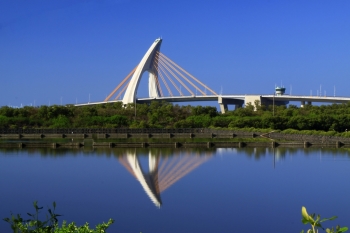|
 Dapeng Wan (Albatross Bay) National Scene Park
Dapeng Wan (Albatross Bay) National Scene Park
Dapeng Wan (Albatross Bay) is located at Nanping Neighborhood of Donggang Township. It crosses both Linbian village and Donggang Town, and is where the two rivers Houliao Creek and Linbian Creek flow into the ocean. Dapeng Wan is a lagoon with a rich diversity of fish and mollusks. The lagoon occupied a total area of 1438 hectares over both land and water and once provided rich aquatic resources that Jiading Manor was dependent upon. The richness of the lagoon gave the manor a nickname of “Golden Jiading Harbor”. During the Japanese Occupation, the Japanese constructed a seaplane base in Dapeng Wan as a base of operations for their southern campaign. After Taiwan was returned to Chinese rule, the base became a junior academy for the Republic of China Air Force and later transformed into a training center of defensive artillery for the three military branches. The military camps were moved to Fangshan mountains when Dapeng Wan was to be developed as a national scene park. National Scenery Development Park of Dapeng Wan includes the lagoon regions, camping areas and Qingzhou recreational zone. It is a project developed by the Department of Tourism in the Ministry of Transportation. It is also the first national scenery park to be developed by using civilian contractors using the BOT system. Dapeng Wan was originally the chief base of oyster farming and cage system aquaculture. Oyster racks at Dapeng Wan became one of its most famous characteristic sights. An island of oyster shells, left over from oyster harvests, gradually formed and became a grazing site for seabirds. People can also walk onto this island where daily tours in bamboo rafts are provided to take tourists to the lagoon for fishing. Tours on bamboo rafts hence became a famous tourist activity prior to Dapeng Wan becoming a national scene park. There is also a restaurant on the sea in the lagoon. A large mangrove forest is located along the public road leading from Donggang to Linbian next to Dapeng Wan. The management has designated the mangrove forest as a protected site and enacted relevant management measures. Renpeng recreational park is constructed by the roadside where visitors can enjoy an intimate tour within the mangrove woods. The mangrove forest is also a haven for bird watchers, attracting large numbers of nesting seabirds. Dapeng Wan National Scenery Park is also planning other facilities such as an international tourist hotel, theme park, marina and golf course.
|

